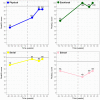The Use of Patient-Reported Outcome Measures in Daily Clinical Practice of a Pediatric Nephrology Department
- PMID: 35564731
- PMCID: PMC9102002
- DOI: 10.3390/ijerph19095338
The Use of Patient-Reported Outcome Measures in Daily Clinical Practice of a Pediatric Nephrology Department
Abstract
(1) Background: Health-related quality of life (HRQoL) is lower in patients with chronic kidney disease (CKD) compared to the general population. In 2011, the KLIK PROM portal was implemented in the Emma Children's Hospital to monitor and discuss HRQoL in daily care. This study describes and assesses the implementation and use of the KLIK PROM portal in the pediatric nephrology department. (2) Methods: CKD patients (self-report, if 8-18 years of age) and their parents (proxy-report, if 1-8 years) were invited to complete HRQoL patient-reported outcome measures (PROMs): TNO-AZL Preschool children Quality Of Life (TAPQOL) or Pediatric Quality of Life Inventory for Children (PedsQL). The PROMs were completed before and discussed during outpatient consultations. The adaptation rate-the proportion of patients/parents who were invited and completed at least one PROM-was calculated. Reported HRQoL scores of CKD patients were compared to the general population. (3) Results: In total, 142 patients (proxy- and self-report) were invited, 112 patients completed at least one PROM (adaptation rate 79%). Patients (n = 84 with informed consent for scientific use) with CKD reported lower HRQoL and HRQoL was more often impaired compared to the general Dutch population. (4) Conclusions: The implementation of KLIK was successful and its use is feasible for daily care. Using KLIK, HRQoL problems can be easily identified and monitored.
Keywords: HRQoL; PROMs; chronic kidney disease; kidney transplantation; pediatric.
Conflict of interest statement
The authors declare no conflict of interest.
Figures




Similar articles
-
Options for the Interpretation of and Recommendations for Acting on Different PROMs in Daily Clinical Practice Using KLIK.Med Care. 2019 May;57 Suppl 5 Suppl 1:S52-S58. doi: 10.1097/MLR.0000000000001061. Med Care. 2019. PMID: 30985597
-
Patients' and parents' perspective on the implementation of Patient Reported Outcome Measures in pediatric clinical practice using the KLIK PROM portal.Qual Life Res. 2022 Jan;31(1):241-254. doi: 10.1007/s11136-021-02950-x. Epub 2021 Jul 29. Qual Life Res. 2022. PMID: 34324137 Free PMC article.
-
Monitoring health related quality of life in survivorship care of young adult survivors of childhood cancer using web-based patient-reported outcome measures: survivors' and health care practitioners' perspectives on the KLIK method.Qual Life Res. 2024 Jan;33(1):145-156. doi: 10.1007/s11136-023-03504-z. Epub 2023 Aug 24. Qual Life Res. 2024. PMID: 37615734 Free PMC article.
-
Navigating Choices in Nephrology: The Role of Patient-Reported Outcomes and Preferences in Economic Evaluations and Decisions in Health Care.Semin Nephrol. 2024 May-Jul;44(3-4):151554. doi: 10.1016/j.semnephrol.2024.151554. Epub 2024 Sep 3. Semin Nephrol. 2024. PMID: 39227210 Review.
-
A patient-centred approach to measuring quality in kidney care: patient-reported outcome measures and patient-reported experience measures.Curr Opin Nephrol Hypertens. 2017 Nov;26(6):442-449. doi: 10.1097/MNH.0000000000000357. Curr Opin Nephrol Hypertens. 2017. PMID: 28806191 Review.
Cited by
-
Routine use of patient-reported experience and outcome measures for children and young people: a scoping review.Syst Rev. 2024 Nov 28;13(1):293. doi: 10.1186/s13643-024-02706-x. Syst Rev. 2024. PMID: 39609878 Free PMC article.
-
How subjective well-being, patient-reported clinical improvement (PROMs) and experience of care (PREMs) relate in an acute psychiatric care setting?Eur Psychiatry. 2023 Feb 17;66(1):e26. doi: 10.1192/j.eurpsy.2023.12. Eur Psychiatry. 2023. PMID: 36797203 Free PMC article.
-
A scoping review of the electronic collection and capture of patient reported outcome measures for children and young people in the hospital setting.PLOS Digit Health. 2025 Jan 6;4(1):e0000704. doi: 10.1371/journal.pdig.0000704. eCollection 2025 Jan. PLOS Digit Health. 2025. PMID: 39761210 Free PMC article.
References
-
- Tjaden L.A., Grootenhuis M.A., Noordzij M., Groothoff J.W. Health-related quality of life in patients with pediatric onset of end-stage renal disease: State of the art and recommendations for clinical practice. Pediatr. Nephrol. 2016;31:1579–1591. doi: 10.1007/s00467-015-3186-3. - DOI - PMC - PubMed
Publication types
MeSH terms
LinkOut - more resources
Full Text Sources
Medical

